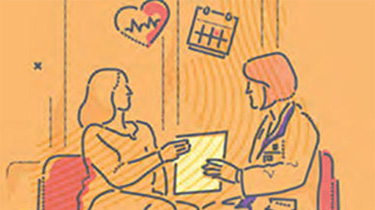
A profound shift toward coordinated, responsive care is underway in American medicine. This shift has the power to transform health care by improving quality, reducing costs and boosting satisfaction, while making care available to more people, at their convenience.
For example, imagine that your aging mother has been ill all day. She tells herself it was something she ate, but she’s feeling woozy. She doesn’t want to call you at work, and she is reluctant to dial 911 because she believes ambulances are embarrassing and expensive.
Patients and their families face dilemmas like this every day. But leading-edge medical thinkers are redesigning health care to make it more patient-centered and coordinated, integrating the possibilities of technology and the requirements for business success.
For instance, in some OptumCare medical practice networks, the mother in the example above has a phone number she can call any time. If she needs in-person evaluation, but not a trip to the ER, a nurse practitioner (NP) will arrive at her door within 30 minutes, even in the middle of the night.
This skilled NP can check her heart rate and blood pressure, review her medications to check for a dangerous drug interaction, and order additional tests based on her history.
In this case, the NP might identify diabetes-related dehydration due to elevated blood sugar levels. With this information, your mother is willing to go to a hospital for IV hydration and insulin support.
In some cases, your mother’s doctor might consult via a videoconference connection. Her familiar primary care physician (PCP) can easily review the NP’s notes and any new prescriptions or health measures in the electronic medical record.
If needed, the PCP can refer her to a specialist for in-depth examination or “prescribe” exercise at a medical practice-owned lifestyle center.
Special-delivery medical care
In cases like the one above, people receive personalized care and better outcomes, while maintaining more of the comfort, privacy and dignity that matter to us all. Most important, every medical visit is part of a coordinated effort to handle care needs promptly and safely.
Well-coordinated medical care, of course, offers another highly desirable benefit: convenience. In this age of online banking and ordering pizza with the tap of an app, people are demanding more convenient health care at an astounding rate.
In 2015, neighborhood “retail” health clinics, offering vaccines, sports exams and care for basic illnesses, took care of 10.5 million people at more than 1,800 locations. Urgent care clinics, offering after-hours and some acute care, numbered 7,000 and continue to flourish.
House calls also are making a comeback. Medicare paid for 2.6 million home visits by physicians, nurses and clinicians in 2013, and the agency is studying whether these visits save money. Where state laws allow, some medical practices offer virtual house calls, in which people consult with their doctor over Skype or a similar secure service.
To be sure, some of the building blocks of “new” coordinated care delivery systems are not new. In the 1960s, house calls accounted for 40 percent of physician-patient encounters, and telemedicine to rural regions has been around for decades.
Today, technology can connect care sites, like the strands of a spider’s web, to your electronic health record, allowing your primary physician to stay in the loop, no matter which site provides the best care option for a particular situation at a given time.
Connecting care across the health continuum
We can realize the full value of new ways to deliver care only when care is coordinated, guidelines are adopted and information systems are effectively linked. Ideally, physicians and their care teams will be able to capture data from each appointment.
Over time, this data provides a fuller picture of a person’s health. Physicians and other care providers then can use their clinical skills and evidence-based care protocols to select the interventions that will benefit an individual the most.
Right now, OptumCare, among others, is testing bits and pieces of tomorrow’s personalized, coordinated health care reality with different populations in various markets.
Monarch HealthCare, an OptumCare 2,500-physician multispecialty practice in Southern California, offers options such as in-home palliative care, a mobile van that performs outpatient cardiac testing and ambulatory surgery centers where people return home the same day.
Southwest Medical, an OptumCare practice with 350 primary and specialty care providers in Las Vegas, offers 24/7 virtual visits for non-urgent needs. Patients can access care via their computer or mobile device. Wait times are minimal, averaging less than four minutes.
These care delivery additions demonstrate that we are in the midst of a revolution that puts human beings’ needs and preferences at the center of how we deliver care. Our goal is to make health care as convenient and accessible as ordering a pizza online — and far better for everyone’s health.
About the author:
Kurt Tamaru, MD, MBA, FAAFP, is chief clinical officer of OptumCare, and leads the development of national standards for physician care delivery.
Related Content

The intergrated care path

Rediscovering the joy of medicine
Sources: Convenient care: http://www.rwjf.org/content/dam/farm/reports/issue_briefs/2015/rwjf419415
Medicare home visits: http://www.modernhealthcare.com/article/20150619/NEWS/306199979
House calls are nothing new: http://www.modernhealthcare.com/article/20150619/NEWS/306199979
Physician shortage: http://www.marketplace.org/2016/01/20/education/cure-doctor-shortage-primary-care-and-teamwork; http://www.aafp.org/news/practice-professional-issues/20150303aamcwkforce.html
Medicare value-based care: https://www.cms.gov/Newsroom/MediaReleaseDatabase/Fact-sheets/2015-Fact-sheets-items/2015-01-26-3.html


